Keywords
Istranca stream, Fish fauna, Cyprinidae
Introduction
Turkey has a substantial biodiversity in re-spect to its geographical location. While totally 236 freshwater fish species inhabit in the inland waters of Turkey (Kuru, 2004), this number is increasing with some new studies (Freyhof and Özulu?, 2006; Turan et al., 2006a; Turan et al., 2006b; Özulu? and Freyhof, 2007a; Özulu? and Freyhof, 2007b; Özulu? and Freyhof, 2008; Tu-ran et al., 2008a; Turan et al., 2008b; Turan et al., 2008c; Freyhof and Özulu?, 2009a; Freyhof and Özulu?, 2009b; Küçük et al., 2009; Turan et al., 2009a; Turan et al., 2009b; Schöter et al., 2009; Freyhof and Özulu?, 2010; Turan et al., 2011; Özulu? and Freyhof, 2011; Turan et al., 2012a; Turan et al., 2012b; Turan et al., 2013).
Lake Durusu is located on the northwestern of Istanbul near the coasts of the Black Sea and is 70 km away from the city center. The lake was a lagoon until 1883 and the connection with the Black Sea was supplied by a canal named Dar-bo?az. The lagoon was blocked by a regulator constructed for drinking water resource. Because of Lake Durusu is rich in terms of streams and all of the surface waters and streams flow to the lake, it became freshwater lake in due time (Baylan and Karadeniz 2006; Özulu?, 2008). One of the main water supply of the lake is Istranca stream which has 443 km2 basin (Figure 1).
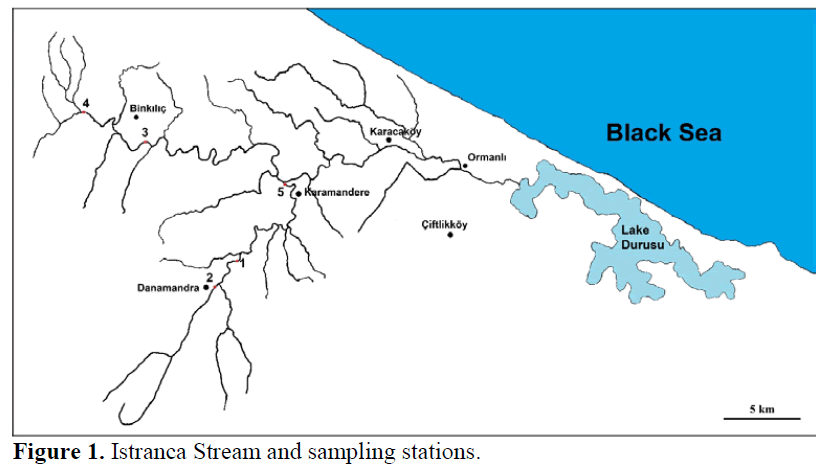
Figure 1: Istranca Stream and sampling stations.
Devedjian (1926), Battalgil (1941), Kosswig and Battalgil (1943), Ladiges (1960), Bal?k (1985), Geldiay and Bal?k (1996) had mentioned totally 20 freshwater fish species present in the lake. But the most detalied research about the fish species of the Lake Durusu Basin and the Is-tranca Stream was studied by Özulu? (2008) and a total of 27 fish species belonging to 10 families were identified. According to Turan et al., (2013), this number has increased to 28 with oc-currence of Alburnoides tzanevi Chichkoff, 1933 in Lake Durusu.
There is no detailed study about the fishes of Istranca Stream that is the most important stream feeding the Lake Durusu. The aim of the study is to present the fish fauna of the Istranca Stream with new records.
Materials and Methods
The present study was carried out in Is-tranca Stream between March 2012 and June 2013. The fish specimens were collected by electroshocker. For morphological examina-tion, some specimens from every species were preserved in 5% formaldehyde solution and stored as museum material in Istanbul University Science Faculty Hydrobiology Museum-IUSHM. The other specimens were studied to determine their biological charac-teristics. During the analysis of the fish, the taxonomic order suggested by Nelson (2006) was used, and the names of species were at-tributed following Eschmeyer (2013).
Results and Discussion
During the surveys, totally 19 fish species were captured from the Istranca Stream. These specimens are Alburnoides tzanevi (Bloch, 1782), Alburnus istanbulensis Battalgil, 1941, Barbus cyclolepis Heckel, 1837, Carassius gibelio (Bloch, 1782), Gobio bulgaricus Drensky, 1926, Leucaspius delineatus (Heckel, 1843), Petroleu-ciscus borysthenicus (Kessler, 1859), Phoxinus strandjae Drensky, 1926, Rhodeus amarus (Bloch, 1782), Rutilus frisii (Nordmann,1840), Rutilus rutilus (Linnaeus, 1758), Squalius cepha-lus (Linnaeus, 1758), Vimba vimba (Linnaeus, 1758), Cobitis pontica Vasil’eva & Vasil’eva 2006, Esox lucius Linnaeus, 1758, Knipowitschia caucasica (Berg, 1916), Neogobius cf. euryceph-alus (Kessler, 1874), Neogobius gymnotrachelus (Kessler, 1857), Neogobius melanostomus (Pal-las, 1814), Proterorhinus semilunaris (Heckel, 1839), respectively. Five fish species, C. gibelio (Bloch, 1782), G. bulgaricus Drensky, 1926, L. delineatus (Heckel, 1843) P. strandjae Drensky, 1926 and R. rutilus (Linnaeus, 1758) were rec-orded for the first time for Durusu Lake Basin.
The species, C. gibelio (Figure 2), G. bulgari-cus (Figure 3), L. delienatus (Figure 4), P. strandjae (Figure 5) and R. rutilus (Figure 6) were captured from 5 different stations in Is-tranca Stream. The station coordinates and indi-vidual numbers for each species were given in Table 1.
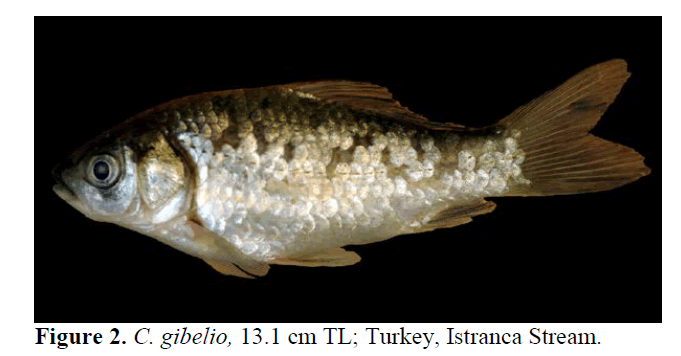
Figure 2: C. gibelio, 13.1 cm TL; Turkey, Istranca Stream.
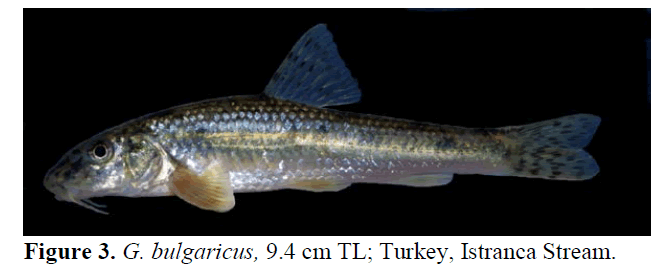
Figure 3: G. bulgaricus, 9.4 cm TL; Turkey, Istranca Stream.
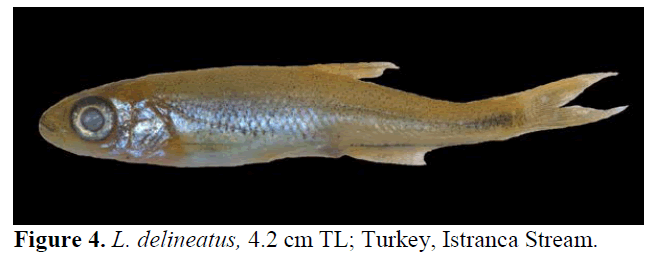
Figure 4: L. delineatus, 4.2 cm TL; Turkey, Istranca Stream.
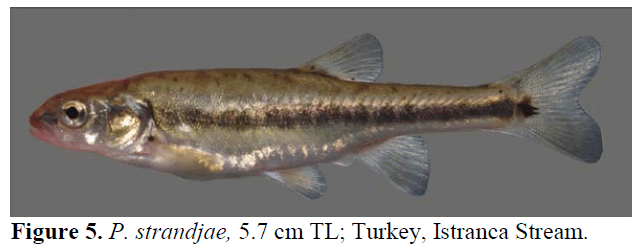
Figure 5: P. strandjae, 5.7 cm TL; Turkey, Istranca Stream.
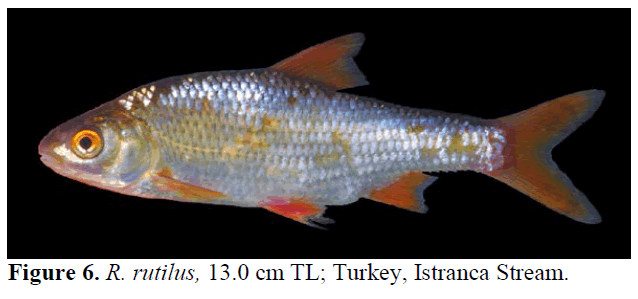
Figure 6: R. rutilus, 13.0 cm TL; Turkey, Istranca Stream.
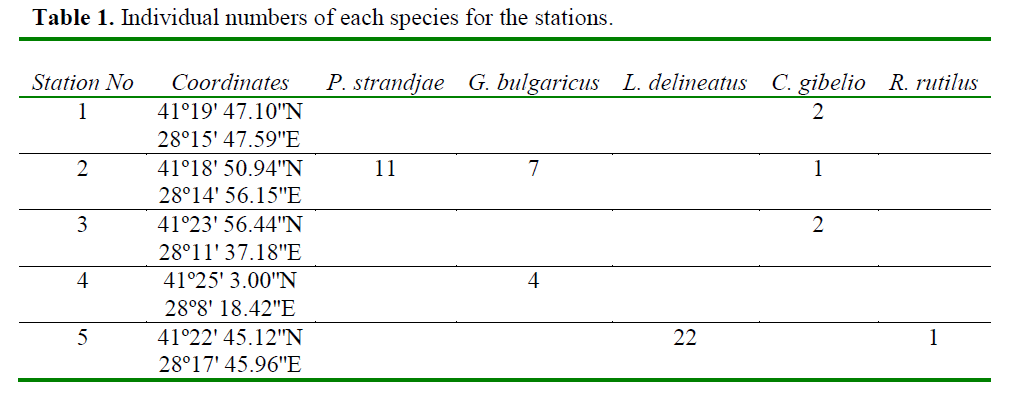
Table 1: Individual numbers of each species for the stations.
Carassius gibelio (Bloch, 1782)
Material examined: 1 specimen, total length 7.8 cm, Station 2- 41º18'50.94''N 28º14'56.15''E, 6 April 2012; 2 specimens, total length 6.0-7.6 cm, Station 1 - 41º19'47.10''N; 28º15'47.59''E, 6 April 2012; 1 specimen, total length 9.4 cm, Sta-tion 3 - 41º23'56.44''N; 28º11'37.18''E, 15 June 2012; 1 specimen, total length 13.1 cm, Station 3 - 41º23'56.44''N; 28º11'37.18''E, 20 June 2013.
Gobio bulgaricus Drensky, 1926
Material examined: 4 specimens, total length 8.7-9.7 cm, Station 4 - 41º25'3.00''N; 28º8'18.42''E, 4 April 2012; 7 specimens, total length 5.5-7.2 cm, Station 2 - 41º18'50.94''N; 28º14'56.15''E, 16 May 2012,
Leucaspius delineatus (Heckel, 1843)
Material examined: 9 specimens, total length 2.4-3.3 cm, Station 5 - 41º22'45.12''N; 28º17'45.96''E, 12 March 2012; 10 specimens, total length 2.7-3.9 m, Station 5 -41º22'45.12''N; 28º17'45.96''E, 17 January 2013; 3 specimens, total length 3.2-4.5 cm, Station 5 - 41º22'45.12''N; 28º17'45.96''E, 19 February 2013.
Phoxinus strandjae Drensky, 1926
Material examined: 11 specimens, total length 4.3-7.1 cm, Station 2 - 41º18'50.94''N; 28º14'56.15''E, 5 May 2012.
Rutilus rutilus (Linnaeus, 1758)
Material examined: 1 specimen, total length 13.0 cm, Station 5 - 41º23'56.44''N; 28º11'37.18''E, 18 April 2013.
C. gibelio described as an invasive fish spe-cies for Turkish inland waters (Özulu? et al., 2004) was recorded for the first time from Gala Lake in Turkey (Baran and Ongan, 1988) and in-troduced the other drainage systems in Thrace shortly (Özulu? et al., 2004; Özulu?, 1999), how-ever it has not reported from Lake Durusu by Özulu? (2008). Only 5 individuals of C. gibelio were captured during the research in Istranca Stream. There is no data about the situation of the species in Lake Durusu but it can be easily adapted and become one important fish species for the lake because of its successful spawning strategy and high ability at colonization for new environments. Due to this reason, the monitoring study should be carried out for Lake Durusu as soon as possible.
P. strandjae was firstly described from Is-tranca range in Bulgaria by Drensky at 1926, but he did not state on which slope the species had been obtained. At 1951, he stated that the speci-mens had been collected from the Veleka and Rezve drainages, draining from Istranca to Black Sea in Bulgaria and Turkey (Kottelat, 2007). The species was only known from these two drainage systems and with this study the distribution area of the species has widen.
Two Gobio species, G. kovatschevi and G. bulgaricus were identified from Thrace region (Kottelat and Freyhof, 2007; Turan et al. 2012a). The natural distribution area of the G. ko-vatschevi is only known from the River Prova-diskaya in Bulgaria and the other Gobio species G. bulgaricus is known from Bulgaria, Greece, Macedonia and Turkey (Kottelat and Freyhof, 2007). Turan et al. (2012a) has identified Gobio specimens lived in Istranca Stream (D. Turan has confirmed that, this stream is not in the Durusu basin and draining to the Black Sea at K?rklareli (pers. comm.)) as G. kovatschevi and, in Meriç and Ergene rivers as G. bulgaricus.
L. delienatus is a small cyprinid species diag-nosed with incomplete lateral line with about 2-12 pored scales (Berg, 1949). It can be easily confused by little chubs at first sight with body form and having large silvery scales. L. deline-atus is native to Thrace and Anatolian coast of Sea of Marmara in Turkey (Kottelat and Freyhof, 2007, Gaygusuz et al. 2013), however it has rec-orded from Kura and Aras drainages (Kuru, 1980), too.
R. rutilus widely distributed in Europe, the Black Sea and Azov Sea basin occurs Büyükçekmece, Apolyont, Manyas and Sapanca lakes, Seyhan Dam Lake and streams in Samsun city (Geldiay and Bal?k, 1996; Ergüden et al., 2008). The monitoring study should be carried out for the population structure of this species in Lake Durusu because of it prefers lentic systems mostly.
Conclusion
In conclusion, the Lake Durusu Basin is rich as a regard to fish fauna. Until today, although some reports have been given on the fauna of the Lake Durusu, new fish species still appear from the streams feeding the lake. It could be said that detailed field survey is very important for the systematic faunal studies.
4
References
- Balik S., (1985). Trakyabölgesiiçsubaliklarininbugünküdurumuvetaksonomikrevizyonu, DogaBilimDergisi, 9: 147-160
- nBattalgil F., (1941). Les poissons des eaux do-uces de la Turquie, Istanbul Üniversitesi Fen FakültesiMecmuasi, B6: 170-186
- nBaran, I., Ongan, T., (1988). Gala Gölü’nünlimnolojiközellikleri, balikçiliksorunlariveöneriler, Gala GölüveSorunlariSempozyumu, DogalHayatiKorumaDernegiBilimselYayinlarSerisi, Istanbul. s: 46 – 54
- nBerg, L. S. (1949). [Freshwater fishes of the U.S.S.R. and adjacent countries. Part. 2. Fo-urth edition]. IzdatelstvoAkademiiNauk SSSR, Moskva& Leningrad, pp. 470-925 [in Russian; translation: Israel Program for Scientific Translations, Jerusalem, 1965]
- nBaylan, E., Karadeniz, N., (2006). TerkosGölü (Istanbul) ÖrnegindeDogalveKültürelÇev-renin KorunmasiveGelistirilmesiÜzerineBirArastirma, TarimBilimleriDergisi, 12(2): 151-161
- nDevedjian K., (1926). Pecheetpecheries en Turquie. Imprimerie De L'Administration De La DettePubliqueOttomane, Istanbul, Turkey
- nDrensky, P., (1926). Neue und selteneFischeausBulgarien, Travaux de la SociétéBulgare des Sciences Naturelles, 12: 121-150
- nDrensky, P., (1951). Fauna of Bulgaria. Vol. 2. Fishes of Bulgaria. Isdanie ne BulgarskataAkademianaNauka, Sofia, 270 pp
- nErgüden (Alagöz), S., Ergüden, D., Göksu, M. Z. L., (2008). The growth properties of roach (RutilusrutilusL., 1758) in the Seyhan Dam Lake (Adana), Journal of FisheriesScien-ce.com, 2(1): 77-87. doi: 10.3153/jfscom.2008008
- nFreyhof, J., Özulug, M., (2006). Pseudophoxinusninae, a new species from Central Anatolia, Turkey (Teleostei: Cyprinidae), Ichthyologi-cal Exploration of Freshwaters, 17(3): 255-259
- nFreyhof, J., Özulug, M., (2009a). Pseudophoxi-nus evliyae, a new species of spring minnow from Western Anatolia with remarks on the distribution of P. ninaeand the systematic position of P. fahirae(Teleostei: Cypri-nidae), Ichthyological Exploration of Freshwaters, 20: 309-318
- nFreyhof, J., Özulug, M., (2009b). Pseudophoxi-nus fahrettini, a new species of spring min-now from Central Anatolia (Teleostei: Cyp-rinidae), Ichthyological Exploration of Freshwaters, 20: 325-332
- nFreyhof, J., Özulug, M., (2010). Pseudophoxinushittitorum, a new species of spring minnow from Central Anatolia (Teleostei: Cypri-nidae), Ichthyological Exploration of Freshwaters, 21: 239-245
- nGaygusuz, Ö.,Emiroglu, Ö., Tarkan, A. S., Aydin, H., Top, N., Dorak, Z., Karakus, U., Baskurt, S., (2013). Assessing the potential impact of nonnative fish on native fish by relative condition, Turkish Journal of Zoology, 37: 84-91
- nGeldiay,, R., Balik, S., (1996). TürkiyeTatlisuBaliklari. (2 edn). EgeÜniversitesiBasimevi Izmir, Turkey
- nKosswig, C., Battalgil, F., (1943). Türkiyetatlisubaliklarininzoogeografikehemmiyeti, TürkFizikiTabiiIlimlerSosyetesiYillikBildirilerArsivi, 8, 18-31
- nKottelat, M., (2007). Three new species of Phox-inusfrom Greece and southern France (Te-lostei: Cyprinidae), IchthyologicalExplora-tion of Freshwaters, 18(2): 145-162
- nKottelat, M., Freyhof, J., (2007). Handbook of European freshwater fishes. Publications Kottelat, Cornol, 646 pp
- nKottelat, M., (2007). Three new species of Phox-inusfrom Greece and southern France (Te-lostei: Cyprinidae), IchthyologicalExplora-tion of Freshwaters, 18(2): 145-162
- nKuru, M., (1980). TürkiyeTatlisuBaliklari Kata-logu. HacettepeÜniversitesi Fen FakültesiYayinlariYardimciKitaplarDizisi, Seri: 12, Bölüm:1, Sayi:1
- nKuru, M., (2004). Recent systematic status of inland water fishes of Turkey, GaziÜniver-sitesiGaziEgitimFakültesiDergisi, 24(3): 1-21
- nKüçük, F., Turan, D., Sahin, C., Gülle, I. (2009). Capoetamauriciin. sp., a new species of cyprinid fish from Lake Beysehir, Turkey (Osteichthyes: Cyprinidae), Zoology in the Middle East, 47: 71-82. doi: 10.1080/09397140.2009.10638349
- nLadiges, W., (1960). Süsswasserfische der Tür-kei, 1. Teil: Cyprinidae, MitteilungenausdemHamburgischenZoologischen Museum und Institut, 58: 105-150
- nNelson, J.S., (2006). Fishes of the world. 4th edi-tion. John Wiley and Sons, Inc., New York
- nÖzulug, M., (1999). A taxonomic study on the fish in the basin of Büyükçekmece Dam Lake, Turkish Journal of Zoology, 23: 439-451
- nÖzulug, M., Meriç, N., Freyhof, J., (2004). The distribution of Carassiusgibelio(Bloch, 1782) (Teleostei: Cyprinidae) in Thrace (Turkey). Journal of Middle East, 31: 63- 66
- nÖzulug, M., Freyhof, J., (2007a). Alburnus demi-ri, a new species of bleak from Western An-atolia, Turkey (Teleostei: Cyprinidae), Ich-thyological Exploration of Freshwaters, 18(4): 307-312
- nÖzulug, M., Freyhof J., (2007b). Rediagnosis of four species of Alburnusfrom Turkey and description of two new species (Teleostei: Cyprinidae), Ichthyological Exploration of Freshwaters, 18(3): 233-246
- nÖzulug, M., (2008). The fish fauna of the Durusu Lake Basin (Istanbul-Turkey), Istanbul Uni-versity Faculty of Science Journal of Biolo-gy, 67(1): 73-79
- nÖzulug, M., Freyhof, J. (2008). Capoetaturani, a new species of barbel from River Seyhan, Turkey (Teleostei: Cyprinidae). Ichthyologi-cal Exploration of Freshwaters, 19(4): 289-296
- nÖzulug, M., Freyhof, J., (2011). Revision of the genus Squaliusin Western and Central Ana-tolia, with description of four new species (Teleostei: Cyprinidae), Ichthyological Ex-ploration of Freshwaters, 22: 107-148
- nSchöter, C., Özulug, M., Freyhof, J., (2009). Capoetacaelestis, a new species from Gök-su River, Turkey (Teleostei: Cyprinidae), Ichthyological Exploration of Freshwaters, 20: 229-236
- nTuran, D., Kottelat, M., Kirankaya, S.G., Engin, S., (2006a). Capoetaekmekciae, a new spe-cies of cyprinid fish from northeastern Ana-tolia (Teleostei: Cyprinidae), Ichthyological Exploration of Freshwaters, 17(2): 147-156
- nTuran, D., Kottelat, M., Ekmekçi, F.G., Imamoglu, H. O., (2006b). A review of Capoetatinca, with descriptions of two new species from Turkey (Teleostei: Cyprinidae), Revue Suisse de Zoologie, 113(2): 421-436
- nTuran, D., Ekmekci, F.G., Ilhan, A., Engin, S., (2008a). Luciobarbuskottelati, a new spe-cies of barbel (Teleostei: Cyprinidae) from the Büyük Menderes River, Turkey, with re-diagnose of L. lydianus, Zootaxa, 1824: 35-44
- nTuran, D., Kottelat, M., Ekmekçi, F.G., (2008b). Capoetaerhani, a new species of cyprinid fish from Ceyhan River, Turkey (Teleostei: Cyprinidae), Ichthyological Exploration of Freshwaters, 19(3): 263-270
- nTuran, D., Kottelat, M., Ekmekçi, F.G., (2008c). Barbusniluferensis, a new species of barbel (Teleostei: Cyprinidae) from Nilüfer River,Turkey, with re-description of B.oligolepis, Zootaxa, 1981: 15–28
- nTuran, D., Yilmaz, B.T., Kaya, C., (2009a). Squaliuskottelati, a new cyprinid species (Teleostei: Cyprinidae) from Orontes River, Turkey, Zootaxa, 2270: 53-62
- nTuran, D., Kottelat, M., Engin, S. (2009b). Two new species of trouts, resident and migrato-ry, sympatric in streams of northern Anatolia (Salmoniformes: Salmonidae), Ichthyologi-cal Exploration of Freshwaters, 20(4): 333-364
- nTuran, D., Kottelat, M., Bektas, Y., (2011). Salmotigridis, a new species of trout from Tigris River, Turkey (Teleostei: Salmon-idae), Zootaxa, 2993: 23-33
- nTuran, D., Ekmekçi F.G., Luskova V., Mendel, J., (2012a). Description of a new species of genus Gobio from Turkey (Teleostei: Cy-prinidae), Zootaxa, 3257: 56-65
- nTuran, D., Kottelat, M., Engin, S., (2012b). The trouts of the Mediterranean drainages of southern Anatolia, Turkey, with descrip-tion of three new species (Teleostei: Salm-onidae), Ichthyological Exploration of Freshwaters, 23(3): 219-236
- nTuran, D., Ekmekçi, F.G., Kaya, C., Güçlü, S.S., (2013). Alburnoidesmanyasensis(Actinop-terygii, Cyprinidae), a new species of cypri-nid fish from Manyas Lake basin, Turkey, ZooKeys, 276: 85-102. doi: 10.3897/zookeys.276.4107
- nEschmeyer, W.N. (ed). (2013). Genera, Species, References. (https://research.calacademy.org/research/ichthyology/catalog/fishcatmain.asp). Electronic version accessed 20 June 2013. [This ver-sion was edited by Bill Eschmeyer.]













